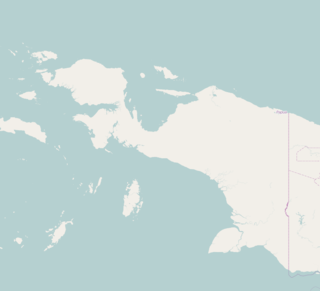
Porome, also known as Kibiri, is a Papuan language of southern Papua New Guinea. There are over a thousand speakers.

The South or East Bougainville languages are a small language family spoken on the island of Bougainville in Papua New Guinea. They were classified as East Papuan languages by Wurm, but this does not now seem tenable, and was abandoned in Ethnologue (2009).

The Fasu language of New Guinea is not closely related to other languages but forms a possible branch of the Trans–New Guinea (TNG) family. Wurm and Hattori (1981) considered its three principal dialects, Fasu, Some and Namumi, to be three languages, which they called the West Kutubuan family, but Glottolog considers it a single language. It is not particularly close to the two East Kutubuan languages.

The Bosavi languages are a family of the Trans–New Guinea languages in the classification of Malcolm Ross.
The Walio languages are a small family of clearly related languages, Walio, Pei, Yawiyo, and Tuwari, though they are not close: Walio and Yawiyo have only a 12% lexical similarity. They are frequently classified among the Sepik languages of northern Papua New Guinea, though Glottolog leaves them out.

Maybrat, also spelt Mai Brat or Majbrat, is a Papuan language spoken by the Ayamaru and Karon Dori peoples of the Maybrat Regency on the Bird's Head Peninsula of New Guinea. Ayamaru dialect is spoken in the many villages around the Ayamaru Lakes. It is only distantly related to other languages, sharing 10% of its vocabulary with its nearest neighbors, though it may be part of the West Papuan family.

Mpur, is a divergent language of New Guinea. It is not closely related to any other language, and though Ross (2005) tentatively assigned it to the West Papuan languages, based on similarities in pronouns, Ethnologue and Glottolog list it as a language isolate. Amberbaken or Mpur has a complex tonal system with 4 lexical tones and an additional contour tone, a compound of two of the lexicals. Its tonal system is somewhat similar to the nearby Austronesian languages of Mor and Ma'ya.

Abun, also known as Yimbun, Anden, Manif, or Karon, is a West Papuan language spoken along the northern coast of the Bird's Head Peninsula. It is not closely related to any other language, and though Ross (2005) assigned it to the West Papuan family, based on similarities in pronouns, Ethnologue and Glottolog list it as a language isolate.

Morori is a moribund Papuan language of the Kolopom branch of the Trans–New Guinea family. It is separated from the other Kolopom languages by the intrusive Marind family. All speakers use Papuan Malay or Indonesian as L2, and many know Marind.

Uhunduni, also known as Damal and Amung after two of its dialects, is the language of the Amung people. It is a Trans–New Guinea language that forms an independent branch of that family in the classification of Malcolm Ross (2005).

Dem is a possible Trans–New Guinea language in the classification of Malcolm Ross (2005). A small number of words connect it to other language families of the Irian Highlands, but they are not consistent correspondences, and it is not clear what they mean. The only pronouns which have been recorded are 1sg nau, 2sg aŋ, and 1pl yu.

Mor is a nearly extinct Trans–New Guinea language of Indonesia. It forms a tentative independent branch of that family in the classification of Malcolm Ross (2005). However, the only connections are the 1sg and 2 ng pronouns na- and a-:

Pawaia, also known as Sira, Tudahwe, Yasa, is a Papuan language that forms a tentative independent branch of the Trans–New Guinea family in the classification of Malcolm Ross (2005). Although Pawaia has reflexes of proto-Trans–New Guinea vocabulary, Ross considers its inclusion questionable on available evidence. Usher classifies it instead with the Teberan languages.
The Orya–Tor languages are a family of Papuan languages spoken in Indonesia.
Brem (Barem), also known as Bunabun, is a Papuan language of Madang Province, Papua New Guinea.
The Arafundi languages are a small family of clearly related languages, namely
KambotAKAAp Ma, is a Ramu language of Papua New Guinea of unclear affiliation.
Nabi (Nambi), a.k.a. Metan, is a Torricelli language of Papua New Guinea. It was assigned to the Maimai branch in Ross (2005).
Musar, also Aregerek and Vanembere, is a Papuan language of Madang Province, Papua New Guinea.
Hatam–Mansim is a small language family of New Guinea, consisting of two languages:
Malcolm David Ross is an emeritus professor of linguistics at the Australian National University. He has published work on Austronesian and Papuan languages, historical linguistics, and language contact. He was elected as a Fellow of the Australian Academy of the Humanities in 1996.
Andrew Kenneth Pawley, FRSNZ, FAHA, is Emeritus Professor at the School of Culture, History & Language of the College of Asia & the Pacific at the Australian National University. Pawley was born in Sydney but moved to New Zealand at the age of 12.

The International Standard Book Number (ISBN) is a numeric commercial book identifier which is intended to be unique. Publishers purchase ISBNs from an affiliate of the International ISBN Agency.












